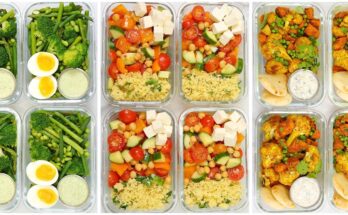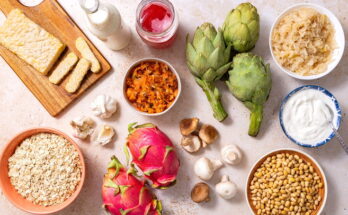Macaroon Biscuit Recipe: Macaroon biscuits are one of those treats that instantly bring joy with their chewy, sweet, and slightly crisp texture. They are often confused with the French macaron, but they are actually quite different. While French macarons are delicate, pastel-colored sandwich cookies made with almond flour and filled with cream, macaroon biscuits are simpler, rustic, and made mainly with coconut, egg whites, and sugar. They are chewy on the inside and slightly golden on the outside, making them an absolute delight with tea, coffee, or even as a quick snack.
One of the best things about macaroon biscuits is how easy they are to make compared to macarons. You don’t need to worry about complicated piping techniques or getting the perfect “feet” on your cookies. Instead, you just need a handful of ingredients, a baking tray, and a bit of patience while they bake to perfection. Whether you’re a beginner in baking or a seasoned cook, this recipe will guide you step by step to ensure your macaroons turn out soft, chewy, and delicious every time.
Macaroon biscuits have a long history, with variations enjoyed worldwide. In Italy, for instance, almond-based amaretti biscuits resemble macaroons, while in America, coconut macaroons are especially popular around holidays like Passover and Christmas. Regardless of where they come from, these biscuits hold a special place in many kitchens and hearts.
What Makes Macaroons Special?
Macaroon biscuits stand out because of their unique balance of texture and flavor. Unlike many other cookies that are crispy throughout, macaroons give you a contrast of a crunchy exterior with a moist, chewy center. This makes them highly satisfying for people who love cookies with a bite that lingers.
Another special quality is their naturally gluten-free nature (if made without flour). Since macaroons are made primarily from coconut and egg whites, they are a great option for people who are sensitive to gluten but still crave sweet baked goods. They are also extremely versatile—you can dip them in chocolate, add nuts, or even infuse them with citrus zest for a refreshing twist.
The beauty of macaroon biscuits lies in their simplicity. With minimal ingredients and effort, you can create a batch of homemade cookies that taste like a gourmet treat. They also store well, so you can bake a large batch and enjoy them over several days.
Difference Between Macarons and Macaroons
The confusion between macarons and macaroons is common, mainly because of their similar names. However, they are two entirely different baked goods:
- Macaroons are rustic, chewy coconut-based biscuits. They are simple to make, require no fancy techniques, and are more forgiving to beginners. They often look like little mounds of golden coconut and taste rich and sweet.
- Macarons (with one “o”) are delicate French sandwich cookies made from almond flour, egg whites, and sugar. They are colorful, smooth, and filled with ganache, buttercream, or jam. They are notoriously tricky to bake and require precision and practice.
To put it simply: if you want something quick, chewy, and indulgent—macaroons are your go-to. If you want an elegant, delicate treat that looks like it belongs in a Parisian café—macarons are the answer. For this guide, we’ll focus on the easy, irresistible macaroon biscuits that anyone can whip up at home.
Ingredients You’ll Need
To make the perfect batch of macaroon biscuits, you only need a handful of ingredients that are probably already in your pantry. Here’s a detailed list of what you’ll need:
Essential Ingredients for Macaroon Biscuits
- Shredded Coconut (2 ½ cups) – The star ingredient. Unsweetened shredded coconut works best, but you can use sweetened if you prefer extra sweetness.
- Egg Whites (2 large) – Help bind the ingredients together and give the biscuits their chewy texture.
- Granulated Sugar (¾ cup) – Adds sweetness and helps the biscuits crisp up slightly.
- Vanilla Extract (1 teaspoon) – Enhances the flavor with a subtle aroma.
- Salt (a pinch) – Balances the sweetness and brings out the flavors.
Optional Add-Ins for Flavor Variations
Want to take your macaroon biscuits to the next level? Try experimenting with these optional add-ins:
- Chocolate Chips – For a double dose of sweetness.
- Dried Fruit – Cherries, cranberries, or raisins work beautifully.
- Nuts – Almonds, pistachios, or cashews for added crunch.
- Zest of Lemon or Orange – For a refreshing citrus twist.
- Drizzle of Melted Chocolate – Makes them look and taste more decadent.
Choosing the Right Quality Ingredients
The flavor of macaroon biscuits heavily depends on the quality of your ingredients. For best results:
- Use unsweetened shredded coconut, as sweetened varieties can make the biscuits overly sugary.
- Choose fresh eggs—room-temperature egg whites whip up better and give a fluffier texture.
- Opt for pure vanilla extract instead of imitation for a more authentic flavor.
- If dipping in chocolate, use good-quality dark or semi-sweet chocolate for richness.
By selecting high-quality ingredients, your macaroons will taste bakery-worthy, even if made in a simple home kitchen.
Kitchen Tools and Equipment Required
Before you start baking, it’s important to prepare the right tools and equipment. Here’s what you’ll need for smooth baking:
Baking Tools for Perfect Macaroons
- Mixing bowls (one large, one medium)
- Electric hand mixer or whisk
- Measuring cups and spoons
- Baking tray
- Parchment paper or silicone baking mat
- Spatula for folding ingredients
- Cooling rack
Preparing Your Workspace
A clutter-free kitchen makes baking easier and more enjoyable. Before you begin:
- Preheat your oven to 170°C (340°F).
- Line your baking tray with parchment paper to prevent sticking.
- Measure all ingredients beforehand for accuracy and smoother workflow.
Once everything is set, you’ll be ready to move on to the fun part—mixing and baking!
Step-by-Step Guide to Making Macaroon Biscuits
Now that you have your ingredients and tools ready, let’s dive into the step-by-step process of baking these delicious biscuits.
Step 1 – Preparing the Ingredients
Gather your ingredients before you start. You’ll need shredded coconut, egg whites, sugar (or sweetener if you prefer a lighter version), a pinch of salt, and a little vanilla extract for flavor. Optional extras like melted chocolate or almond slivers can also be added for variation.
Step 2 – Mixing the Batter
In a mixing bowl, whisk the egg whites with a pinch of salt until they become foamy. Gradually add the sugar and continue whisking until the mixture turns glossy. Fold in the shredded coconut and vanilla extract until everything is evenly combined. The batter should be sticky but hold its shape when scooped.
Step 3 – Shaping the Macaroons
Line a baking tray with parchment paper. Using a spoon or small ice cream scoop, drop mounds of the coconut mixture onto the tray, spacing them a little apart. You can leave them round or shape them into small peaks for a more traditional look.
Step 4 – Baking to Perfection
Preheat your oven to 325°F (160°C). Bake the macaroons for 18–22 minutes, or until the tops are lightly golden and the edges are crisp. Keep a close eye on them, as coconut can brown quickly.
Step 5 – Cooling and Serving
Remove the tray from the oven and let the macaroons cool completely on a wire rack. Once cooled, you can drizzle them with melted chocolate or dip the bottoms for an extra treat. Serve them fresh with tea, coffee, or as a sweet snack.
Tips for Perfect Macaroon Biscuits
Even though macaroons are fairly simple, a few expert tips can make the difference between good and great results.
Common Mistakes to Avoid
- Using whole eggs instead of just whites – This makes the mixture too runny.
- Overmixing the batter – Causes dense, tough macaroons.
- Not lining the tray – They’ll stick and break apart.
- Baking at too high a temperature – Leads to burnt edges and raw centers.
How to Get the Perfect Texture
- Use room-temperature egg whites for better binding.
- Toast the shredded coconut lightly before mixing for a deeper flavor.
- Let the mixture rest before shaping to absorb excess moisture.
Best Storage Practices
- Store in an airtight container away from moisture.
- For long-term storage, freeze in single layers with parchment paper in between to prevent sticking.
- Reheat in the oven for 2–3 minutes if you want to refresh their crispiness.
Flavor Variations to Try
Macaroon biscuits are delicious in their classic coconut form, but experimenting with flavors can make them even more exciting. Since the base recipe is simple, it works like a blank canvas where you can add unique twists. Here are a few mouthwatering variations to try:
Chocolate-Dipped Macaroons
Chocolate and coconut are a match made in dessert heaven. To create chocolate-dipped macaroons:
- Prepare your classic macaroon biscuits and let them cool completely.
- Melt good-quality dark or semi-sweet chocolate in a heatproof bowl over simmering water (or in short bursts in the microwave).
- Dip the bottoms of the macaroons into the melted chocolate, then place them on parchment paper until the chocolate sets.
This simple addition transforms a humble cookie into a decadent treat. You can even drizzle extra chocolate over the top for a professional look.
Almond and Coconut Macaroons
For a nuttier twist, almonds add a wonderful crunch and flavor that pairs beautifully with coconut.
- Add ½ cup of finely chopped or slivered almonds to the batter.
- If you prefer stronger almond flavor, replace the vanilla extract with almond extract.
- Top each macaroon with a whole almond before baking for an elegant touch.
These almond-coconut macaroons are especially perfect during festive seasons and make for great edible gifts.
Fruit-Flavored Macaroons
Adding fruit can brighten up the flavor of your biscuits. Dried fruits are best because they don’t release extra moisture that could affect the texture.
- Mix in dried cranberries, cherries, or apricots for a tangy-sweet balance.
- For a tropical variation, add dried pineapple or mango pieces.
- To enhance freshness, add 1 teaspoon of lemon or orange zest to the batter.
This variation is a hit during summer or when you want a lighter, fruity dessert.
Serving Suggestions
While macaroon biscuits taste fantastic on their own, pairing and presenting them thoughtfully can elevate the entire experience.
Pairing with Beverages
- Tea: Earl Grey or chamomile tea complements the sweetness beautifully.
- Coffee: A rich espresso or cappuccino balances the chewy coconut texture.
- Milk: A cold glass of milk makes them a comforting treat, especially for kids.
- Wine: If you’re serving them at a dinner party, pair with a sweet dessert wine like Moscato or a light sparkling wine.
As a Dessert for Special Occasions
Macaroons can be dressed up to shine at special gatherings:
- Holiday Platters: Add them to a tray with other festive cookies like gingerbread or shortbread.
- Wedding or Party Favors: Wrap individual macaroons in decorative paper or small boxes.
- Dessert Toppings: Crumble macaroons over ice cream, yogurt, or fruit salad for added crunch.
- Layered Desserts: Use them as layers in trifles or parfaits to add a chewy element.
Their versatility makes them an easy go-to dessert for almost any occasion.
Nutritional Value of Macaroon Biscuits
Macaroon biscuits may be indulgent, but they can fit into a balanced diet if enjoyed in moderation. Here’s a breakdown of their typical nutritional profile per serving (2 macaroons, without chocolate dip):
| Nutrient | Amount |
|---|---|
| Calories | ~150–180 |
| Carbohydrates | 18–20g |
| Protein | 2–3g |
| Fat | 8–10g |
| Fiber | 2–3g |
| Sugar | 15–18g |
Healthier Ingredient Alternatives
If you want to make your macaroons a little lighter, try these swaps:
- Replace white sugar with coconut sugar or honey for natural sweetness.
- Use unsweetened shredded coconut to cut down on added sugars.
- Swap some of the coconut with ground almonds or oats for extra nutrition.
- For a vegan version, replace egg whites with aquafaba (the liquid from canned chickpeas).
With these small tweaks, you can enjoy macaroon biscuits more often without feeling guilty.
FAQs about Macaroon Biscuit Recipe
Q1: Why are my macaroons too dry?
They may have been overbaked or the mixture was too dry. Next time, reduce baking time slightly or add a bit more egg white.
Q2: Can I make macaroons without eggs?
Yes! You can substitute egg whites with aquafaba (chickpea water). Whip it until frothy before mixing with coconut and sugar.
Q3: How do I stop macaroons from spreading too much?
Make sure your batter is thick enough to hold shape. If it’s too loose, add extra shredded coconut.
Q4: Can I freeze macaroons?
Absolutely. Freeze in an airtight container for up to 3 months. Thaw at room temperature before serving.
Q5: Can I dip macaroons in white chocolate instead of dark?
Yes! White chocolate adds a creamy sweetness that pairs beautifully with coconut.
Conclusion
Macaroon biscuits are one of the easiest yet most satisfying cookies you can bake at home. With just a few ingredients and simple steps, you can create chewy, golden treats that delight everyone. Whether you keep them classic, dip them in chocolate, or experiment with flavors like almond and fruit, macaroons are versatile enough for any occasion.
They pair well with tea, coffee, and even wine, making them a delightful snack or dessert centerpiece. Plus, they’re naturally gluten-free, can be adapted to suit dietary needs, and store well for later enjoyment.
So, the next time you crave something sweet and homemade, whip up a batch of macaroons—you’ll be amazed at how quickly they disappear!



